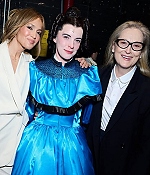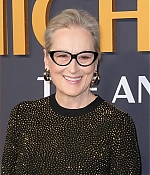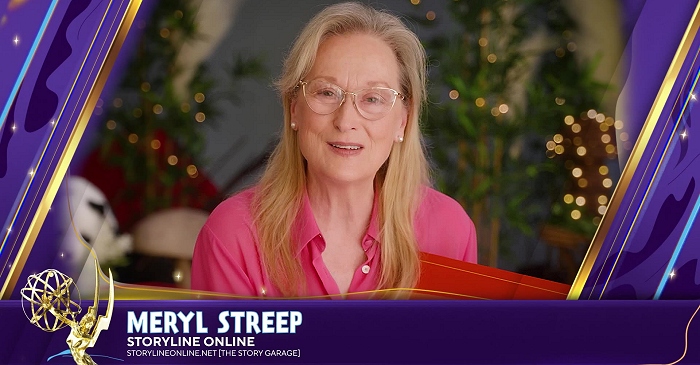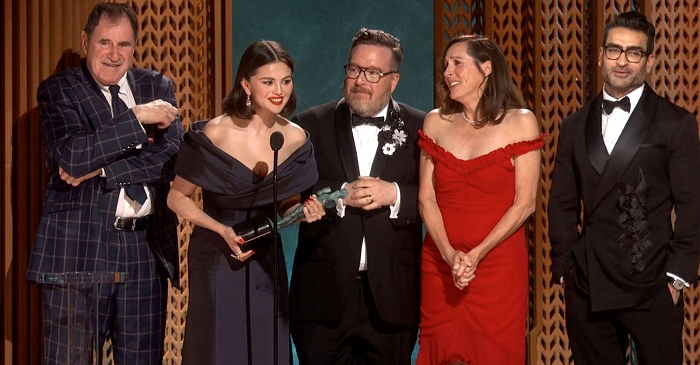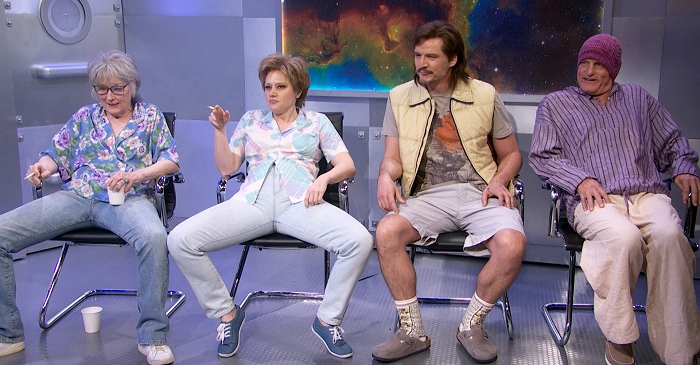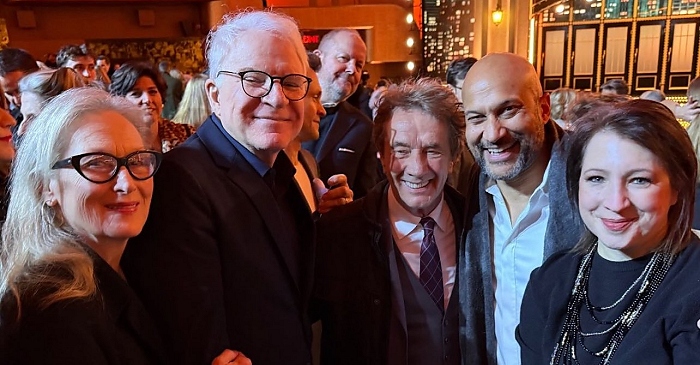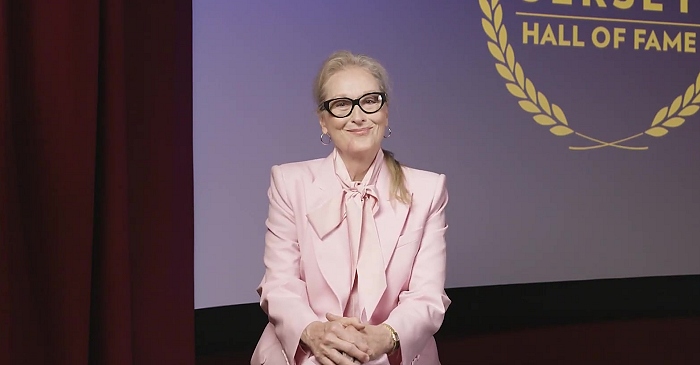|
Simply Streep is your premiere source on Meryl Streep's work on film, television and in the theatre - a career that has won her the praise to be one of the world's greatest working actresses. Created in 1999, we have built an extensive collection to discover Miss Streep's body of work through articles, photos and videos. Enjoy your stay.
|
Celebrating
25 years
of SimplyStreep
|
|
Donegal's Daughter
The Irish Times ·
September 12, 1998
|
Sitting in an air-conditioned suite overlooking Central Park on a humid New York afternoon last month, Meryl Streep was in exuberant form, giving her first interview about working on Pat O’Connor’s film of Dancing at Lughnasa in Ireland last summer. For an actress so often perceived by the media as reserved and remote, she was in high spirits, oozing enthusiasm for the movie which features her finest performance in many years.
“Oh, you’re wearing green shoes,” she declares as I sit down. I explain they are my Ecco walking shoes, very practical for getting about Manhattan, and not some statement of national identity. I also point out that her opennecked blouse is itself coloured a shade of green. “Oh, that’s sea foam,” she says. Pat O’Connor’s superbly crafted and deeply moving film of Dancing at Lughnasa, adroitly adapted by Frank McGuinness from the play by Brian Friel, features Meryl Streep as Kate, the eldest of the five Mundy sisters whose lives are observed over one consequential summer in the small Donegal town of Ballybeg in 1936, after which their lives will never be the same again.
Streep’s subtle, intelligent performance catches all the inner sadness and frustration – and rare, brief moments of joy – in the life of Kate, a woman to whom spontaneity seems an alien concept – and whose job as a schoolteacher is on the line. Meryl Streep seems assured of earning her 11th Oscar nomination for her performance in the film, putting her just one short of the record 12 acting nominations achieved by Katharine Hepburn. She has won two Oscars: as best supporting actress for Kramer Vs Kramer in 1979 and as best actress for Sophie’s Choice in 1982. Would she like to be in the Oscar arena again? “That would be nice,” she says with a twinkle in her eye. “It’s always exciting.”
One of the crowning achievements of Dancing at Lughnasa is the remarkable, wholly unselfish ensemble acting of the five women at its centre. “That’s the way actors love to work,” says Streep. “It’s very rare in films that you get that opportunity. They were magical. We all got on so well together, on and off the set.” She is joined in the film by Kathy Burke as the earth-mother figure, Maggie; Brid Brennan, returning to the role of the quietly courageous Agnes, which won her a Tony award when she played it on Broadway; Sophie Thompson as the simple but fearless Rose; and Catherine McCormack as the youngest sister, Christina, a single mother with a young son.
“You know,” says Streep, “everyone had a different kind of life they were bringing to Dublin. I had my family with me for a few weeks. Brid had her two little boys with her and she was living near me in Dublin. And Sophie had her baby with her, which kept her very occupied when she went home at night.” The fine cast also features Michael Gambon as the sisters’ brother, a missionary returned from Africa; Rhys Ifans as the Welshman who fathered Christina’s love child, Michael; young newcomer Darrell Johnston as Michael, whose memories of that summer are recalled in voiceover by Gerard McSorley; and Lorcan Cranitch as the local married man who embarks on a relationship with Rose.
Meryl Streep says one of the things that helped her understand her character in the film is that she, like Kate, was the eldest child in her family. “I know that burden of feeling that you’re carrying everyone along, and they don’t always appreciate it,” she says. “But you’ve just got to keep going.” She was born Mary Louise Streep – the first and middle names soon merging into Meryl – in Summit, New Jersey, in 1949. Her father was a pharmaceutical company executive and her mother a commercial artist. They had three children – Meryl and her brothers, Harry and Dana. In 1978, Meryl married Don Gummer, a sculptor, and they have four children, Henry (18), Mary Willa (14), Grace (12) and Louisa (7).
In Cannes last year, when producer Noel Pearson proudly announced he had signed Meryl Streep for the film of Dancing at Lughnasa, he remarked that, although she is noted for taking months to decide on scripts offered her, she responded quickly to Frank McGuinness’s Friel adaptation. “I’m sure that’s contextual,” she says. “I’m sure I had read another lot of scripts that just infuriated me and which I turned down, and then came upon this and said yes, partly as a reaction to all the crap that I was being sent.”
She describes Noel Pearson as “a great salesman for his product – anyone who signs up to be in this business as a producer is insane. This business is always a crap-shoot. I’m a salaried worker, I take the job. But to sign up to pay people! Whoah! I’ve done it once, though, just for television.” That project was First Do No Harm, which she says she did as a favour for a friend, Jim Abrahams, the film-maker who was part of the team behind such comedy spoofs as Airplane!. “This was a film with a message, about paediatric epilepsy,” says Streep. “I knew Jim because our kids went to the same school. His son had this affliction and he had multiple surgeries. Jim was able to control the boy’s epilepsy with a diet, but there was no information about this diet. There was only one place that administered it – Johns Hopkins, a venerable medical institution. Jim wanted to get the word out to all the families that would benefit from learning about it.
“He took a story from one of the thousands of letters people had written him since he started his foundation, and he dramatised it, and I played the mother in it. The night we showed it on television, it went out on the ABC network, we put up an 800 number and we got 70,000 calls.” She is pleasantly surprised to hear that the film has been released on video in Ireland and Britain. Streep was immediately drawn to Dancing at Lughnasa, when she read the screenplay. “It was so elegantly written and the characters were woven beautifully,” she says. “It was so subtle – everything was under the text, everything was subtext. But there was a character missing and that was this landscape – which I didn’t really see until I saw the film for myself.
“I’d lived in that landscape and walked around in it, but I didn’t really see it as a character in the film until I saw the film. It had this curious effect on me, having been inside it and now looking at it from the outside. “It’s a very tiny story written in epic proportion. It just really feels like these people are important, and their little story. And I fell I love with their little story because I never see films that are about people that nobody cares about really. There’s nothing gigantic happening to them – it’s a small journey, and such an interior one.

